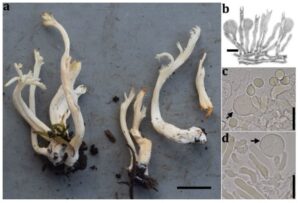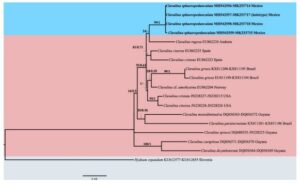Clavulina sphaeropedunculata E. Pérez-Pazos, M. Villegas & R. Garibay-Orijel, sp. nov.
Index Fungorum number: IF 826922; MycoBank number: MB 826922; Facesoffungi number: FoF 05680; Fig. 87
Etymology: sphaeropedunculata (gr. sphaîra=sphere; lat. pedunculus=peduncle; sufx –atus=provided with) epithet assigned due to the presence of sphaeropedunculate cystidia on the hymenial surface, a unique character in this species.
Holotype: FCME 27663.
Basidiocarps Simple to scarcely branched, 10–84 mm long. Stipe well-delimited, 8–37 mm long×1–5 mm wide, pale yellowish white (2A2–4A2), cylindric to irregularly sub fattened, surface is smooth from the base to the apex. Branches Acrotonic branching, b.r.=1–3(4). Scarce branches, dichotomous, lax, cylindrical to irregularly compressed, smooth surface (some with superfcial groove at the base of the branch), pale yellowish white (2A2–4A2), with V axils and U-shaped; hymenium pale yellowish white (2A2–4A2) to orange-white (5A2), and some with a little more creamy patches (4A3) (in younger stages homogeneous pale yellowish white from the base to the top), when dry deep yellow (4A8), to apricot yellow (5B6), and surface with a frostlike appearance, due to the presence of spores. Tips simple, acute to subacute, some rounded (few times cristate), lax, concolorous to branches, becoming drab (6D3) by dehydration. Consistency fbrous-feshy. Context initially solid, yellowish white (4A2), hollow with age. Odor sometimes slightly sweet and imperceptible taste. Basidia fbulate, (32–)40–70(–81.5) × (4.5–)6–7.5(–9) μm, cylindrical to subclavate, thin-walled, hyaline, few with oily content, postpartal septa scarcely observed, 2 sterigmata, (4–)4.5–9(–9.5) μm long, curved. Basidiospores subglobose, hyaline, thinwalled, smooth (7.7–)8.8–9.9(–10.4) × (6.3–)6.8–8.4(–8.8) μm, (L = 8.9–9.6 ± 0.2–0.5, W = 7.2–8.0 ± 0.3–0.5, Q =1.20–1.29±0.04–0.07), obtuse hilar appendix. Cyst idia spheropedunculate, globose, thin-walled, smooth, 31–50×11.5–22 μm, infrequent. Hyphal system monomitic. Subhymenium formed by fbulate hyphae, hyaline, and thinwalled, (4–)4.5–6(–7.5) μm wide.
Habitat and distribution: Gregarious, grows on the ground and woody debris. Develops on temperate forests, alt. 3000–3500 m.
Material examined: MEXICO, Mexico Estado de Mexico City, El Zarco, Insurgente Miguel Hidalgo y Costilla National Park, Ocoyoacac municipality, San Pedro Atlapulco, 19.293° N, 99.355° W, 28 November 2015, Pérez-Pazos-467Z (FCME 27663, holotype); 17 October 2014, Argüelles-Moyao-104 (MEXU 28224); 28 November 2015, Pérez-Pazos-466 (FCME 27664); 28 November 2015, Pérez-Pazos-472 (FCME 27665); MEXICO, Mexico City, El Pantano, Desierto de los Leones National Park, Cuajimalpa district, 19.293° N, 99.323° W, 13 October 2012, PérezPazos-43 (FCME 27666). MEXICO, Estado de Mexico, Zinacantepec, El Contadero de Matamoros, 19.22° N, 99.82° W, 3 September 2008, Endara Agramont ECMMX176-11. ITS (MEXU 26712); Estado de Mexico, Amanalco, Corral de Piedra, 19.22° N, 99.97° W, 21 September 2008, Burrola Aguilar ECMAM152 (MEXU 25781).
GenBank numbers: ITS: MH542557, MH542560, MH542556, MH542559, KT874987, KT874988, MH542558; LSU: MK253717, MK253716, MK253714, MK253718, MK253715; ITS sequence from an ectomycorrhizal root tip: MH542563.
Notes: In the phylogenetic analyses, Clavulina sphaeropedunculata is highly supported (ML=99, PP=1) within the temperate species clade (Fig. 88). The main character that distinguishes C. sphaeropedunculata from other similar species is the presence of sphaeropedunculate cystidia on the hymenial surface, a unique character among all previously reported species of the genus. Species reported with cystidia, generally lack clamped hyphae in the hymenial trama, which is not the case for C. sphaeropedunculata. Some of the species with cystidia are C. alutaceo-siccescens and C. geoglossoides, both reported by Petersen (1988) from the Nothofagus forests of New Zealand. In the former the cystidia are longer (70–100 µm), cylindrical, and occurs in small clusters; in the latter, cystidia rise to 200 µm in length and are often septate. Corner (1950) also reported some species with
cystidia, including C. leveillei, C. pilosa and C. cristata var. incarnata. C. leveillei has cylindrical cystidia, 80–125 µm length; C. pilosa also has cylindric cystidia, hair-like, 6 µm wide that project 30 µm beyond the basidia layer; C. cristata var. incarnata also has long and cylindric cystidia, subventricose, sometimes becoming immersed on the hymenia. In all the species mentioned, there is no cystidia resembling those of C. sphaeropedunculata. It should be noted that cystidia in C. sphaeropedunculata are highly infrequent, so it is likely that specimens of this species, previously deposited

Fig. 87 Clavulina sphaeropedunculata (FCME 27663, holotype). a Simple basidiome, with acute tips. b Basidia and sphaeropedunculate cystidia. c Sphaeropedunculate cystidia and spores. d. Sphaeropedunculate cystidia with smooth surface and thin-walled. Scale bars: a=1 cm, b–d=20 µm

Fig. 88 Phylogenetic tree of Clavulina obtained from the analyses of ITS and LSU sequences showing the phylogenetic position of C. sphaeropedunculata. Numbers above branches represent support values of maximum likelihood bootstrap and Bayesian inference posterior probabilities, respectively. Sequences generated in this work are shown in bold. The tree was rooted with Hydnum repandum
